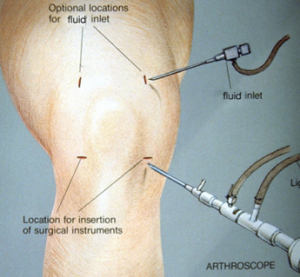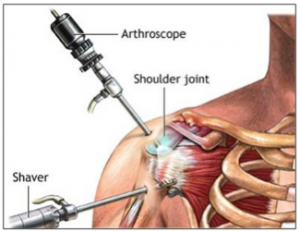The surgical procedure that orthopedic surgeons use to effectively visualize, diagnose, and treat the problems that arise inside a joint, is known as arthroscopy. The word itself is derived from joining two Greek words arthro (joint) and skopein (to look). The word, in its most literal sense, means to look inside a joint.
skopein (to look). The word, in its most literal sense, means to look inside a joint.
The Phoenix orthopedic surgeon, in a typical arthroscopic examination makes a small cut or incision in the patient’s skin and with the help of a thin tube, inserts several pencil sized instruments, i.e. a small lens and lighting system, by which the structures inside the joint are illuminated. Light is then transmitted through fiber optics to the end of the device which is inserted inside the joint, so that the orthopedic surgeon in Scottsdale can see properly.
There is also a miniature television camera attached to the arthroscope device, with the help of which, the Arizona sports medicine surgeon can effectively see the inside of the joint. This is why; even a small incision is perfect for this kind of procedure as compared to a large incision. The camera attached to the device is connected to a television which shows the inside of the joint on the screen by which the surgeon finds it easy to determine the exact amount or type of injury; and what needs to be done to repair or correct it.
Why is Arthroscopy Surgery Necessary?
The initial diagnosis of joint injuries and disease is done by examining the thorough medical history of the patient, conducting a physical examination, as well as an x-ray, MRI and a CT scan. It’s with the help of arthroscopy that the final diagnosis is made, which is much more accurate and safe than ‘open’ surgery or from studying the x-ray.
Orthopedic surgeons benefit a lot from this procedure as arthroscopic examinations help them find the following very effectively:
Inflammation: It’s not very easy to spot inflammation, but with the help of this device, finding inflammation, whether in the knee, shoulder, wrist, elbow, or ankle becomes quite convenient.
Acute or Chronic Injury: The many different injuries are; rotator cuff tendon tears, tears to the cartilage, carpal tunnel syndrome, etc. Surgeons can now easily spot injuries and even determine whether it’s a chronic or an acute one.
In addition to that, there are a number of problems associated with arthritis that can also be treated with the help of arthroscopic surgery combined with standard surgery, such as:
- Rotator Cuff Surgery
- Reconstruction of ACL in knee
- Torn Meniscus Repair from shoulder or knee
- Removal of inflamed lining in shoulder, knee, elbow, wrist and ankle
- Release of Carpal Tunnel
- Torn Ligament Repair
Normally, the inside of nearly every joint can be seen very easily with the help of the arthrocopic device, but there are 6 joints that are most frequently examined by surgeons with this instrument, namely the knee, elbow, shoulder, ankle, hip and the wrist. In the future, with the help of new advancements and technology, surgeons might very well include all the other joints to this list as well, which will no doubt, make it easier to repair other orthopedic conditions as well.
The top sports medicine surgeon in Phoenix and Scottsdale is Dr. Adam Farber. Dr. Farber is Board Certified and Fellowship Trained, with extensive experience in arthroscopic surgery of the knee and shoulder. Call (480) 219-3342 for more information and scheduling today!



